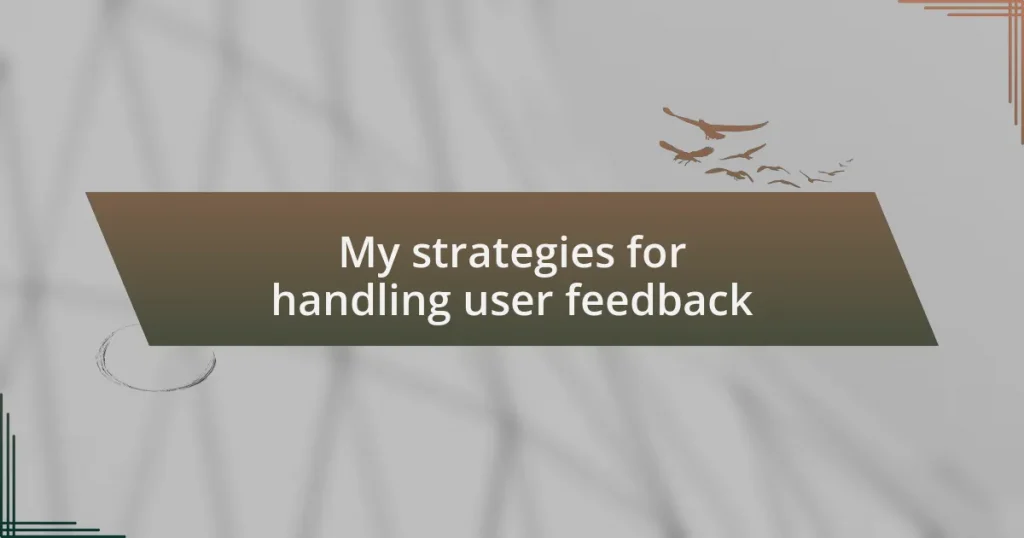Key takeaways:
- Implement short, targeted feedback forms and utilize unobtrusive pop-up surveys to gather user insights effectively.
- Analyze feedback by identifying patterns and categorizing responses, which helps prioritize improvements and enhance user satisfaction.
- Implement user suggestions with flexibility, as small adjustments can lead to significant positive outcomes in user engagement.
- Engage users through direct communication and feedback sessions to ensure design choices align with their needs, fostering a strong designer-user relationship.
Strategies for collecting user feedback
One effective strategy I’ve used is implementing simple feedback forms on key pages of a website. I often prefer to keep these forms short, asking just a couple of targeted questions. This approach not only encourages users to share their thoughts but also shows that their opinions matter to me, creating a more connected user experience.
In my experience, using tools like pop-up surveys can be particularly powerful. While some might see pop-ups as intrusive, I believe they can be crafted in a way that feels unobtrusive and timely. For instance, I once timed a survey to appear after users spent a certain amount of time on the page, which resulted in a higher response rate. This timing allows me to gather insights when users are genuinely engaging with the content.
Finally, I find that direct engagement through social media platforms often reveals invaluable feedback. It’s about fostering a dialogue rather than simply collecting data. When I ask open-ended questions in my posts, I sometimes get responses that are enlightening and unexpected. Have you ever noticed how a casual comment can spark a deeper conversation about what users really want? I cherish those moments, as they provide a rich perspective on my design choices.
Analyzing user feedback effectively
Analyzing user feedback effectively requires a methodical approach to identifying key patterns. When I sift through responses, I look for recurring themes that signal consistent user sentiments. For example, after reviewing feedback from a recent project, I noticed several users expressed frustration over navigation. This insight prompted a redesign that not only enhanced usability but also positively impacted engagement metrics.
I have also found it incredibly beneficial to categorize feedback into positive, negative, and neutral responses. This simple yet effective tactic allows me to highlight strengths and address weaknesses more efficiently. One time, categorizing feedback after a website launch helped me prioritize improvements; we implemented changes based on pain points, leading to a noticeable increase in user satisfaction. Isn’t it fascinating how understanding the emotional undertones of feedback can drive meaningful enhancements?
Another key to effective analysis is maintaining an open mind. There have been occasions when negative feedback initially stung, yet diving deeper revealed opportunities for growth. Embracing criticism and reflecting on its validity can lead to breakthroughs in design. Have you considered how sometimes the harshest insights can become the best stepping stones toward innovation? It’s all about perspective, and I’ve learned that every piece of feedback is a chance to refine my work and better serve my users.
Implementing changes based on feedback
Implementing changes based on user feedback is where the real magic happens. I vividly remember a project where users pointed out an overly complex registration form. By simplifying it and reducing unnecessary fields, we not only streamlined the process but also saw a significant spike in user sign-ups. Isn’t it rewarding to witness how small adjustments can create such a big impact?
During another redesign, user feedback highlighted that our color scheme felt too dull. Although my team was initially attached to our vision, we reached a consensus to incorporate bolder colors based on user suggestions. The result? A fresh and vibrant aesthetic that resonated far better with our audience. These moments remind me that being flexible and receptive to feedback can lead to delightful outcomes.
Sometimes, though, changes don’t always yield the expected results, and that’s okay. I once implemented a feature that seemed promising but didn’t resonate with users as anticipated. Instead of feeling defeated, I took it as a valuable lesson. How often do we learn more from missteps than successes? By openly addressing what didn’t work, I could engage with users again, reinforcing trust and commitment to creating a better experience.
Continuous improvement through user insights
When I think about the role of user insights in continuous improvement, a particular experience stands out. We had launched a new feature designed to enhance user navigation, but the feedback was lukewarm at best. Instead of pushing through, I organized a feedback session where users could voice their thoughts in real-time. Hearing their perspectives firsthand was enlightening. It made me realize that sometimes, our best intentions don’t line up with the actual needs of our users.
There was another instance where we changed the layout of a landing page based entirely on user suggestions. The feedback was compelling—users wanted a more intuitive hierarchy of information. After implementing their ideas, we not only observed increased engagement but also received heartfelt thanks from users who felt heard. Isn’t it incredible how a simple adjustment can make users feel more connected to our work?
I cherish these insights because they keep the design process from becoming stagnant. By continuously inviting feedback, it creates a dynamic relationship between designers and users. One thing I’ve learned is that when users see their voices reflected in the designs, it fosters loyalty and trust. Isn’t that the ultimate goal?
